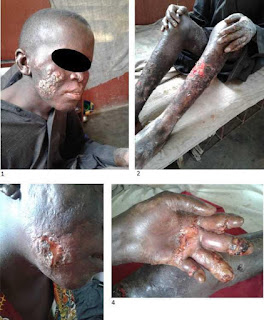Leprosy Mailing List – October 11, 2019
Ref.: (LML) MB-patient from Guinea
From: Joel Almeida, London and Mumbai
Dear Pieter and colleagues,
Dr. Francisco Almeida from Recife, Brazil, wrote in LML on 5 Oct 2019:
"Anergic and bacilliferous cases do not cure with 12 doses of MDT-MB. Often not with 24 doses.
I have several cases similar to yours that required specific multidrug therapy for much longer than WHO recommendations. In some situations, these patients only started to improve after changing the treatment regimen using secondary drugs. Even with negative drug resistance research for commonly tested gene loci (folp1, rpoB and Gyr-A) conducted after 24 doses of MDT-MB treatment.
The images show several areas still with tubercles and infiltrations, clearly demonstrating active disease."
These are well-informed words. Currently, adequate treatment of anergic patients is available in endemic countries from only well-informed private practitioners and academic centres. But the poorer patients with anergy have to settle for the inadequate anti-microbial treatment that has been fashionable during the past 2 decades. This inadequate treatment of LL patients is one of the major reasons why Hansen's Disease (HD) has continued to spread, infecting children and others. An example of the consequences is available from the MB patient from Guinea, on whose behalf Dr. Strahm kindly requested advice.
(images from Dr. Strahm)
These images should be engraved on our minds, so that we fully understand the consequences of our policy of providing only inadequate anti-microbial treatment to patients with anergy. Post-MDT chemoprophylaxis for all LL patients is more humane, and essential. Not only can it protect individuals such as this patient in Guinea, but also it can help us to match Shandong's 20%/year decline in incidence rate leading to near-zero transmission.
For patients with anergy, long-term follow-up (below, 2) confirms Dr. Francisco Almeida's observation that even 24 months of MDT are insufficient.
(based on Balagon et al 2009, ref. 2)
Recurrence rates are even higher than this among patients with a high initial BI. Post-MDT chemoprophylaxis for all LL patients can solve this problem of high recurrence rates after MDT.
Policies, predictions and mathematical models that ignore this central fact of high recurrence rates are liable to mislead us.
We are a compassionate community, committed to science and effective interventions. Therefore, we are open to updating our practices, policies and predictions in line with emerging scientific evidence, better to protect the people we serve. We are all human, so mistakes are inevitable. The important thing is to keep correcting our mistakes and improving our interventions. We are not in favour of negligence.
On a different note, why did Dr. Francisco Almeida's patients respond better to alternative drugs despite showing no drug-resistant mutant bacilli? Rifampicin tolerance is a recently recognised phenomenon in mycobacteria. Rifampicin at relatively low concentrations preferentially inhibits one of the two rpoB promoters within the bacilli, allowing increased rpoB expression from a second promoter, thus triggering bacillary growth among genetically drug-susceptible bacilli. (3) This phenomenon was demonstrated in mycobacteria other than HD bacilli, but it would be unsafe to assume that HD bacilli lack this property. This unusual property of mycobacteria could explain why single-dose rifampicin at 10 mg/kg (SDR-PEP) can provoke bacillary growth and MB disease in contacts of HD patients. Even without that triggering of bacillary growth by SDR, widely-applied SDR-PEP selects rifampicin-resistant bacilli, especially among contacts with undiagnosed and hard-to-diagnose LL disease. This last point is of greatest consequence for continued transmission and eventual widespread multiple-drug resistant failure of treatment.
There is a wealth of expertise among the professionals in endemic countries. We cannot afford to disregard that expertise, well-informed as it is by clues from the front-lines. Continued HD transmission is a human-made problem: our neglect of skin smears allows LL patients to remain undiagnosed, while we have been leaving LLp patients unprotected after MDT. Both these flaws invite prolific transmission of bacilli. We have just celebrated the 150th birth anniversary of Mahatma Gandhi. Like him, we can awaken our inner Mahatma (great soul), make the necessary changes, and succeed.
Meanwhile, LML deserves deep gratitude for being an open forum where anyone from anywhere can bring experiences and insights rapidly to advance our common cause of ending HD and its consequences. Two or three peer reviewers can sometimes overlook major errors. However, it is not so easy to get major errors past LML's many experts. Every disease needs an LML.
Joel Almeida
References
1. Li HY, Weng XM, Li T et al. Long-Term Effect of Leprosy Control in Two Prefectures of China, 1955-1993. Int J Lepr Other Mycobact Dis. 1995 Jun;63(2):213-221.
2. Balagon MF, Cellona RV, dela Cruz E et al. Long-Term Relapse Risk of Multibacillary Leprosy after Completion of 2 Years of Multiple Drug Therapy (WHO-MDT) in Cebu, Philippines. American Journal of Tropical Medicine and Hygiene, 2009; 81, 5: 895-9.
3. Zhu JH, Wang BW, Pan M et al. Rifampicin can induce antibiotic tolerance in mycobacteria via paradoxical changes in rpoB transcription. Nature Communications 2018; 9: 4218.Published online 2018 Oct 11. doi: 10.1038/s41467-018-06667-3
| |
LML - S Deepak, B Naafs, S Noto and P Schreuder
LML blog link: http://leprosymailinglist.blogspot.it/
Contact: Dr Pieter Schreuder << editorlml@gmail.com
You received this message because you are subscribed to the Google Groups "Leprosy Mailing List" group.
To unsubscribe from this group and stop receiving emails from it, send an email to leprosymailinglist+unsubscribe@googlegroups.com.
To view this discussion on the web, visit https://groups.google.com/d/msgid/leprosymailinglist/14fee255-0da9-426b-92a1-efeaac536d65%40googlegroups.com.



No comments:
Post a Comment